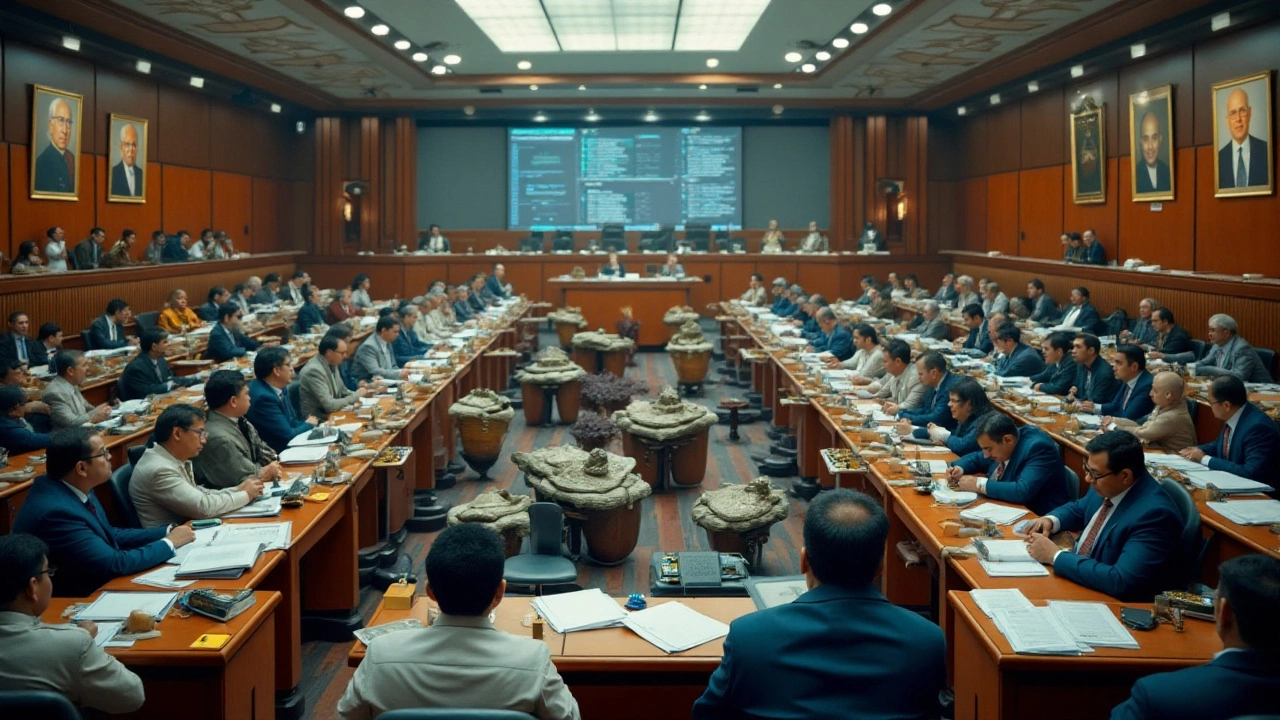Money matters influence every aspect of how a country runs, making the control of government funds a topic of great interest and impact. In a nation as vast and diverse as India, this control is a deeply structured network of organizations and procedures, laid out to ensure funds flow where they are intended and are used effectively.
The machinery of fiscal management in India involves a collaborative operation among several key institutions and regulatory frameworks. Each player has a significant role in steering the direction of public resources, affecting everything from infrastructure projects to social welfare programs. By delving into these roles, we uncover not just the mechanics of financial control but the driving forces behind public service advancements.
- Key Players in India's Financial Management
- Role of the Ministry of Finance
- Involvement of the Reserve Bank of India
- Function of the Comptroller and Auditor General
- Impact on Government Schemes
Key Players in India's Financial Management
When unraveling the labyrinthine structure of who actually controls government money in India, one must understand the intricate interplay between several pivotal entities. Each of these entities plays a crucial role in the deployment, oversight, and management of the public coffers. At the heart of this structure is the Ministry of Finance. This central government department is the nerve center of financial policies, economic affairs, and public funds distribution in the country. It drafts the Union Budget, a comprehensive financial statement detailing government revenue and expenditures, which sets the tone for how funds are allocated across various sectors. The budget, debated intensively within Parliament, acts as a fiscal calendar that the government follows for the coming financial year.
Complementing the Ministry's efforts is the Reserve Bank of India (RBI), the nation's central bank, which operates under a broader mandate than simply managing monetary policy. The RBI oversees the financial stability of the nation, regulates banks, and controls monetary supply by guiding government financial transactions. Through open market operations, bond issuances, and interest rate adjustments, the RBI impacts the accessibility of funds for government schemes. To many, the entity's role might seem arcane, yet it's the RBIs silent assurance that keeps the economic ship steady.
"The strongest tool India has in managing its economy is a blend of astute finance ministry policies and a dynamic RBI," notes Dr. C. Rangarajan, former Governor of the RBI.
The function of auditing and ensuring accountability falls to the Comptroller and Auditor General (CAG). This office plays an indispensable watchdog role, scrutinizing government expenditures to ensure transparency and propriety in handling public resources. The reports generated by the CAG offer a retrospective understanding of fiscal discipline and can initiate corrective action when funds are mismanaged. They meticulously examine how government schemes operate, bringing to light inefficiencies and suggesting improvements.
In addition to these core entities, several other departments and commissions influence fiscal management. These include the Planning Commission, which was recently replaced by the NITI Aayog to strategize long-term economic agendas. The Economic Affairs Department, part of the Ministry of Finance, also takes center stage in formulating economic policies. Amid this complex web, the common goal remains to judiciously manage the public purse, ensuring that funds reach those ambitious projects that aim to uplift society and drive growth.
Role of the Ministry of Finance
The Ministry of Finance in India plays a core role in the national financial structure, functioning as both the architect and custodian of the country's economic health. It is an intricate institution that's responsible for framing the economic policy of the nation, which includes taxation, government expenditure, managing the public revenue, and overseeing financial legislation. The Ministry consists of several departments including Economic Affairs, Revenue, Expenditure, Financial Services, and Investment & Public Asset Management, each contributing toward the financial stability and growth of the nation.
The Department of Economic Affairs is perhaps the most significant wing, handling all crucial microeconomic and financial policy matters, as well as managing the nation's foreign exchange and balance of payments. Meanwhile, the Department of Revenue takes the charge of central direct and indirect tax collection, which is a substantial source of the government's funds. These collected taxes feed into numerous government schemes and developmental projects, bridging the gap between policy making and its impact on ground realities.
A key component within the Ministry is the Department of Expenditure, which is tasked with ensuring that government money is used judiciously, avoiding wastage, and getting the maximum benefit from every penny spent. This department sets the expenditure ceilings for various ministries and departments, which is pivotal in maintaining fiscal discipline. A notable quote often referenced regarding public expenditure is from Dr. Manmohan Singh, a former Finance Minister and Prime Minister:
"Economics is not a discipline sui generis. It is driven by social and political forces."This underscores the fact that financial management isn't just about numbers but about the values and priorities that shape spending.
The Ministry doesn't operate in isolation or in a rigid hierarchical fashion. Instead, it functions within a dynamic network that includes the Reserve Bank of India and the Comptroller and Auditor General among others, collaborating to ensure that policy implementation is both effective and flexible. Committees and panels within the Ministry regularly review financial strategies to adapt to changing economic conditions, ensuring that the country's fiscal policies remain robust and sustainable in the long run.
Interestingly, the Ministry's handling of public funds and its impact on Indian society can often be assessed by looking into the budget speeches delivered by the Finance Minister every year. This spectacle not only lays out the roadmap for the upcoming fiscal year but also provides insights into the government's priorities and stance on various economic issues. The budget document, which is awaited by every stakeholder from businesses to common citizens, is where numbers meet with narratives of growth and development crafted by the Ministry.

Involvement of the Reserve Bank of India
The Reserve Bank of India (RBI) stands as a pivotal institution in managing the nation's economic and financial frameworks. Acting as the central bank, the RBI's role extends beyond the regulation of banking and monetary frameworks; it plays a crucial part in facilitating effective financial management in government schemes. Its mandate covers both currency stability and monetary policy, which requires balancing inflation and interest rates with sustainable growth. In terms of government funds, the RBI functions as the banker and debt manager to the government. It issues and manages securities and treasury bills, which are essential tools that help in raising funds for public schemes.
Every fiscal year, the RBI is at the center of conducting Open Market Operations, which include buying and selling government securities to control the money supply in the economy. These operations help in ensuring liquidity, which is crucial for facilitating government spending without causing inflation. The central bank must maintain a delicate equilibrium between injecting liquidity and curbing excess supply, all while securing public interest and trust. Additionally, the RBI oversees the Government's Cash Balance by maintaining accounts for central and state governments. This aspect ensures that financial allocations from various funds are employed proficiently and reconciled correctly.
"The monetary policy of the RBI is instrumental in stabilizing macroeconomic variables, ensuring that government funds are utilized effectively," remarked a notable economist, highlighting the importance of RBI's role.One of the lesser-known but significant responsibilities includes overseeing the Primary Dealers, who are appointed by the RBI to support government securities' primary market framework, which further influences funding allocation for public schemes. Primary Dealers underwrite issuances of government securities, affecting the cost and availability of funds accessible to the government. It is not merely about regulating; guidance is offered by the RBI to ensure a well-functioning securities market.
The institution also tailors its monetary tools, such as the repo rate, to influence the economic climate, aiming to provide an environment conducive to balanced economic growth. Through this lens, each initiative or modification impacts how efficiently government schemes are financed, inevitably affecting overall economic health. Such an approach juggernauts an accountability mechanism where financial irregularities are minimized, reassuring that public funds are being devoted to their intended purposes, such as infrastructure developments and welfare initiatives.
The operational synergy between the RBI and the Indian government highlights the importance of this guardian of India's monetary ecosystem. A balancing act exists within the RBI in terms of integration with fiscal policies, reconciling economic goals that benefit both the population and the financial market's credibility. Consequently, understanding this multifaceted involvement helps us appreciate how initiatives for national importance are not just funded but fostered through expert financial crafting.
Function of the Comptroller and Auditor General
The Comptroller and Auditor General (CAG) of India holds a pivotal role in overseeing the nation's financial administration, providing valuable fiscal insights and ensuring that public funds are spent judiciously and responsibly across government schemes. As the chief guardian of public finance, the CAG conducts comprehensive audits of accounts related to all expenditures and revenues of the government, which includes both the Central and State levels. Such meticulous scrutiny is vital not only for maintaining transparency but also for fostering accountability among government entities. Established under the Constitution of India, the CAG's authority is a constitutional mandate, making it a pillar of democracy that strengthens public trust in governmental financial processes.
A vital function of the CAG is preparing audit reports that are presented to the President or Governors, emphasizing anomalies, discrepancies, or inefficiencies in government spending, thus offering the legislature an informed basis for policy reviews and interventions. These reports cover a detailed analysis of diverse financial activities, including budget implementation, resource allocation, and execution of government schemes. The involvement of the CAG is critical in evaluating whether government programs achieve intended objectives without wastage of resources. The systematic CAG audits often reveal deeper insights into compliance with laws, efficiency, and effectiveness of financial operations.
Ensuring Public Accountability
One long-standing quote aptly captures this sentiment:
“A responsible financial management is the bedrock of growth and efficacy in national governance.”The CAG serves as a crucial instrument in catalyzing responsible financial governance, advocating for reforms wherever inefficiencies are noted. By recommending changes in policy and management through its well-formulated reports, the CAG plays a transformative role in driving improvements across the administrative spectrum. This ensures that not only are public funds utilized wisely, but government bodies also adopt best practices in order to optimize efficiency and enhance quality of life for citizens.
Impact on Policy and Governance
Through its detailed audits and recommendations, the CAG influences policy makers in budgeting and regulatory decisions that impact various sectors, from agriculture and education to healthcare and infrastructure. By creating a culture of answerability, it tightens the fiscal discipline which profoundly affects the growth trajectory of government schemes across India. The CAG’s reports have instigated essential reforms and often served as a foundational tool for parliamentary committees to hold discussions that result in legislative amendments. Such impact is seen as instrumental in preserving the integrity and efficiency of India’s financial management system, ensuring public funds are channeled equitably and effectively.

Impact on Government Schemes
In India, government schemes serve as pivotal tools for economic growth and social welfare. Their execution and impact hinge significantly on the effective management of public funds. These schemes cover a vast range of areas such as health, education, infrastructure, and poverty alleviation, directly influencing the daily lives of citizens. The distribution and utilization of these public funds determine the accessibility and quality of services provided by the government.
Take, for instance, the Mahatma Gandhi National Rural Employment Guarantee Act (MGNREGA), which aims to enhance livelihood security by providing up to 100 days of wage-employment in a financial year to every rural household. The success of such a scheme relies heavily on timely allocation and release of funds to the respective state governments and beneficiaries. Any delay or mismanagement can lead to significant setbacks in achieving the scheme's objectives. Similar principles apply to other critical initiatives like the Pradhan Mantri Jan Arogya Yojana (PM-JAY), intended to provide health insurance coverage, or the Pradhan Mantri Gram Sadak Yojana (PMGSY), which focuses on rural road connectivity. Each requires meticulous financial oversight to ensure the funds reach their intended recipients and purposes without leakages or misuse.
Ensuring Accountability
Transparency and accountability are crucial in managing these government schemes. Systems like the Direct Benefit Transfer (DBT) have been introduced to reduce fraud and ensure subsidies reach directly to the beneficiaries' accounts. This system is not just a technological innovation but a step towards enhancing the efficacy of public fund disbursement. A report by the Ministry of Finance highlighted that DBT prevented leakages of billions, demonstrating how structured financial control can improve scheme impacts.
The World Bank has lauded India's DBT as "a milestone in enhancing integrity and efficiency in public spending".
Challenges and Opportunities
Despite these mechanisms, challenges like corruption, bureaucratic red tape, and inadequate infrastructure often hinder the desired outcomes. Addressing these issues requires coordinated efforts from all financial managing authorities and continuous policy reforms. Leveraging technology, like Aadhar-based authentication, is an approach that has already been initiated to combat such issues. As India continues to innovate in its public funds management methodologies, opportunities for improvement in service delivery and policy implementation remain vast. This persistent evolution is crucial for the schemes' success and the overall quality of life for millions of Indians.


